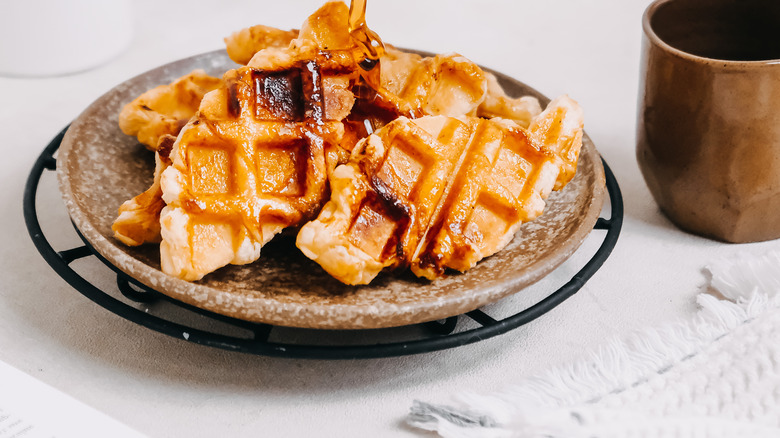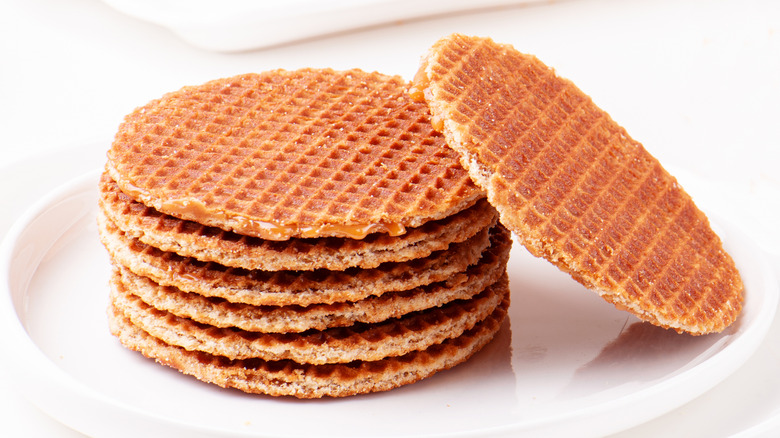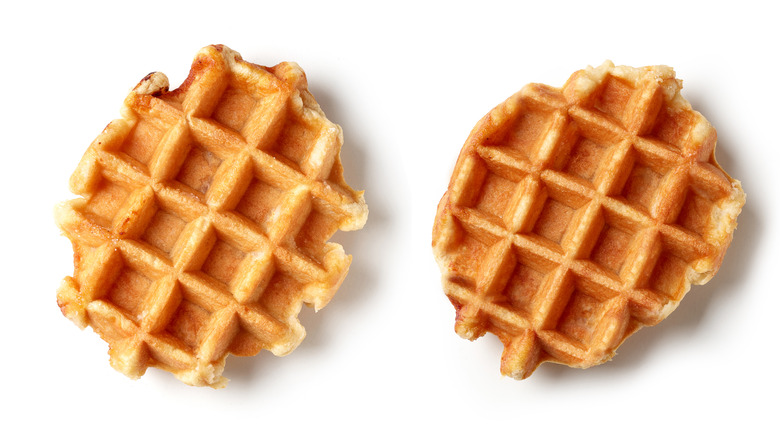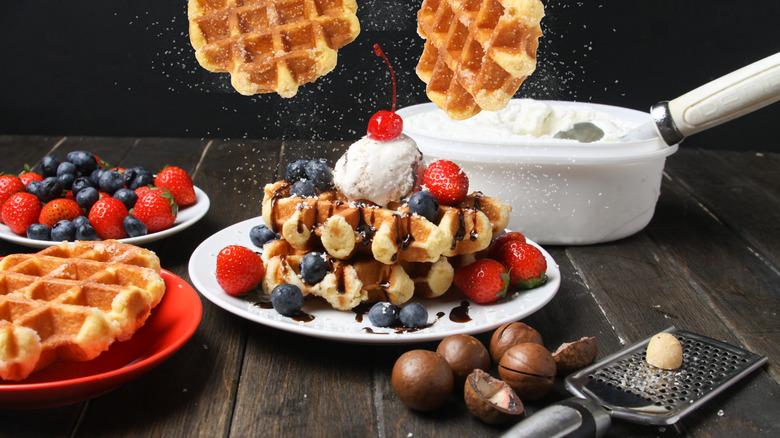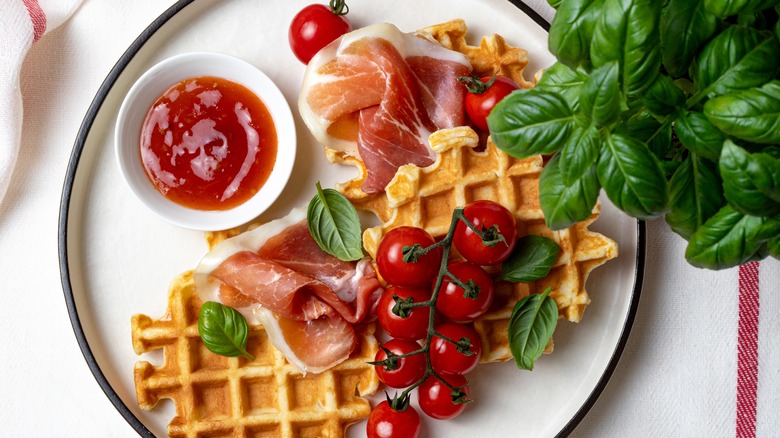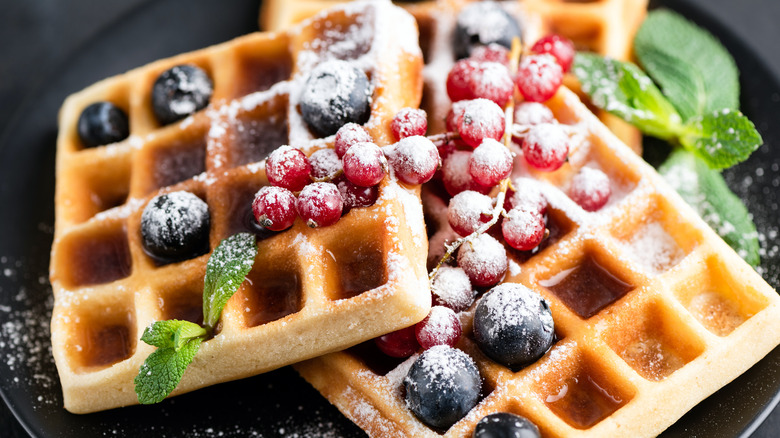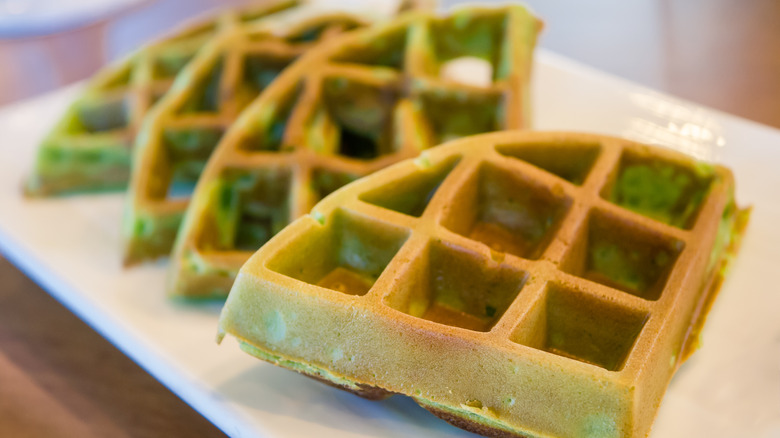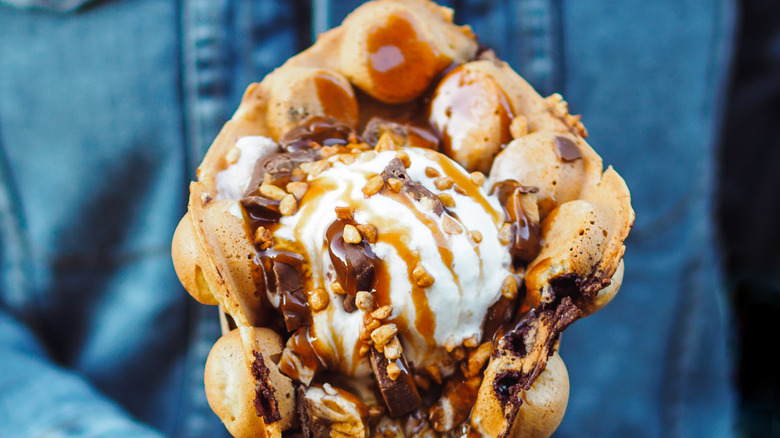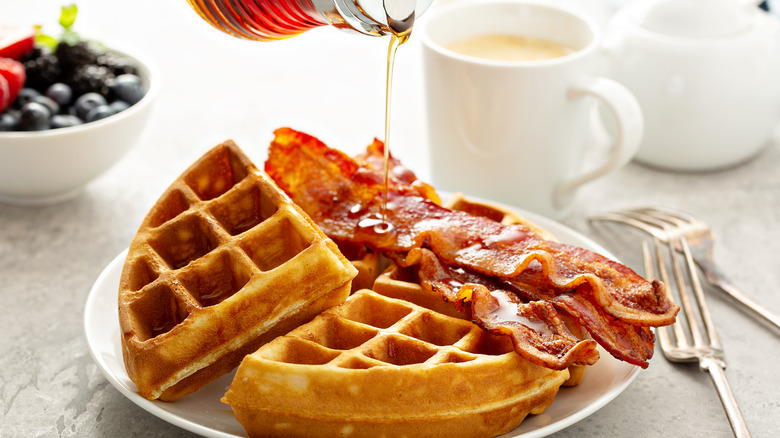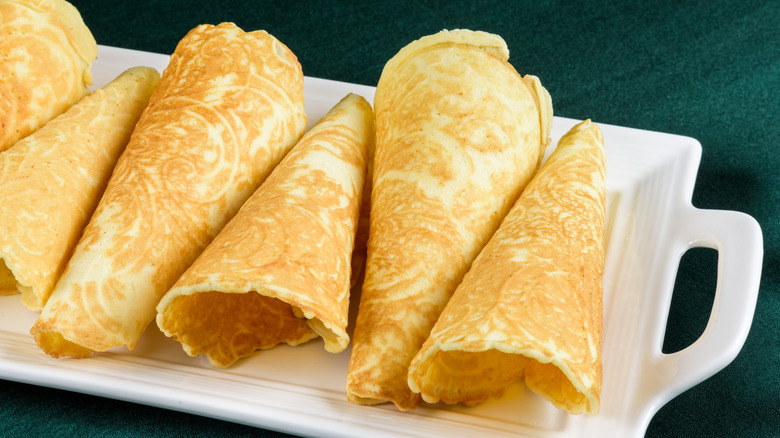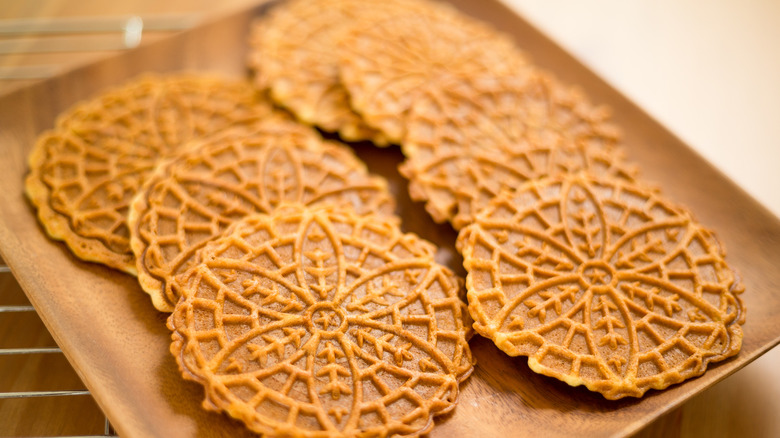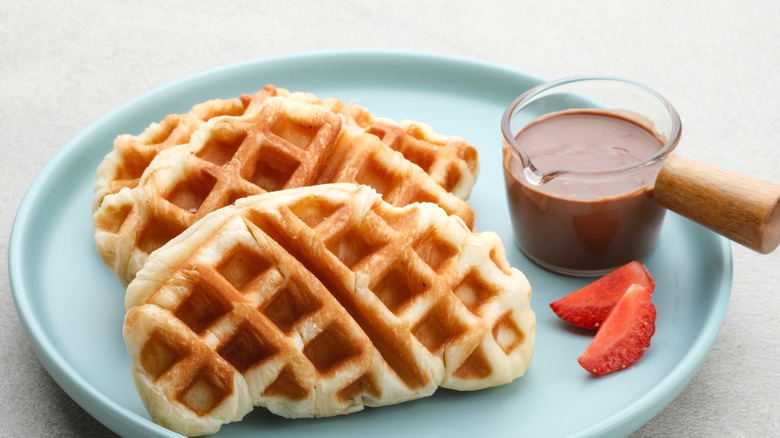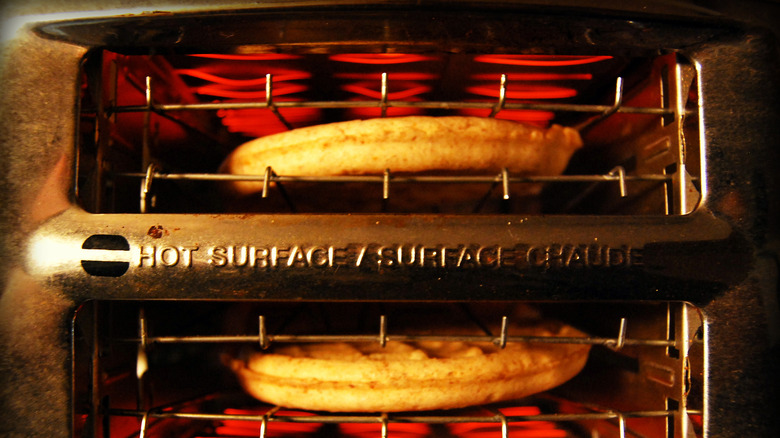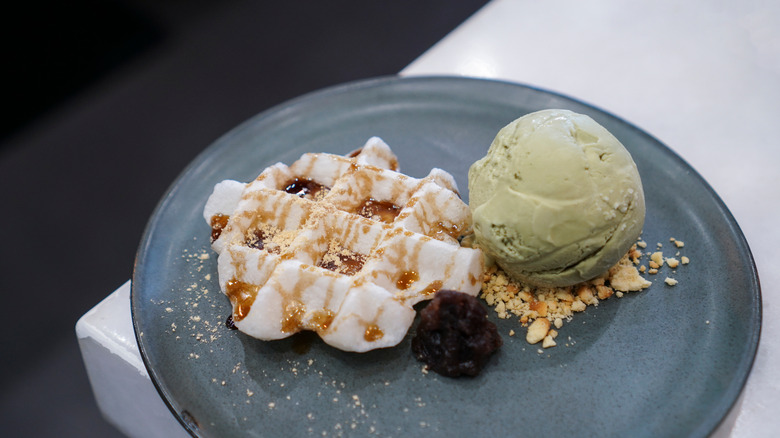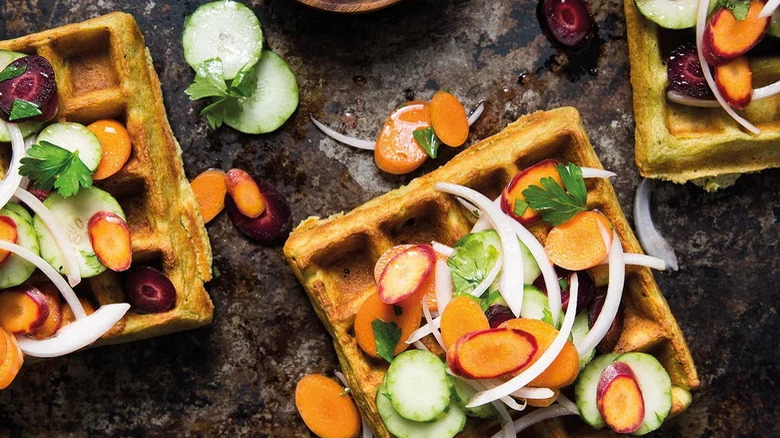16 Types Of Waffles, Explained
We may receive a commission on purchases made from links.
The waffle's history is just as deep and complicated as the ornate design on its exterior. The textured confection can be traced back to at least ancient Greece, and possibly thousands of years before that, per Chicago Waffles. Catholics imprinted crosses and other images into the waffle iron and used the food as a blessing after meals, and eventually, families began incorporating their own designs. They were known as "wafers" throughout Europe and quickly began varying in size, shape, and taste.
European street vendors popularized the waffle's simple design and portability throughout the Middle Ages. The waffle was eaten by the poor and the wealthy alike; more affluent waffle enthusiasts incorporated emulsifiers like eggs, milk, and honey for a more sweet and decadent waffle, according to Garry's Grill. Waffles made their way to the Americas by way of the Pilgrims in 1620 after the Dutch had introduced them to the dessert. Almost two centuries later, Dutch-American Cornelius Swarthout was awarded the first U.S. patent for a waffle iron on August 24, 1869 — a date now celebrated as National Waffle Day.
And what's not to celebrate about waffles? They work as breakfast or dessert and come in so many different packages. Whether you're eating a frozen Eggo on the way to work or crafting a soft, pillowy stack for a Sunday morning brunch, a waffle always hits the spot. To show our appreciation, we've compiled a list of some of the most common waffle variations from around the world.
Stroopwafles
Stroopwafels are characterized by a wafer-thin waffle with a smooth syrup filling. You can eat your stroopwafel warm, when the caramel is at its drippiest point, or allow the cookie to cool and harden. Our favorite way to eat this delightful treat? Smothered with a layer of ice cream in the middle. Dutch Review recommends placing the cookie on top of a warm cup of coffee or tea and allowing the steam to melt the syrup layer inside the cookie just a tad.
This humble cookie actually has very complicated origins. Stroopwafels were once known as a "poor man's cookie" and were initially assembled with leftovers from Dutch bakeries (per Dutch Review). Since the crumbs lacked the moisture to stick together, bakers began adding a thin layer of syrup to combine the ingredients with ease. Eventually, the cookie became so popular that bakers began using a designated iron, called a pizzelle, to make the thin discs for the cookie. Like other waffles, the batter for a stroopwafel is made from flour, butter, sugar, yeast, milk, eggs, vanilla, and cinnamon.
Waffle cones
If you're buying an ice cream cone from a local scoop shop, you should always opt for a waffle cone. A survey has shown that most Americans prefer to eat ice cream in a waffle cone compared to the much less flavorful cake cones or sugar cones. The best part about the waffle cone is that it is sturdy enough for a quick dip in chocolate and sprinkles before being filled with ice cream and served. If you find that the bottom of your waffle cone drips out ice cream, you can add a mini-marshmallow to soak up the melty ice cream and enjoy as a tasty surprise when you get to the bottom of the cone.
According to legend, Syrian baker named Ernest A. Hamwi designed the first waffle cone at the World's Fair in 1904. When a neighboring ice cream vendor ran out of dishes, Hamwi quickly rolled a Syrian waffle-like pastry called a zalabi into a cone. Hamwi went on to found the Missouri Cone Company in 1910.
Belgian waffles
Belgian waffles are also known as yeasted waffles. The yeast in the Belgian waffle results in a much fluffier, lighter texture compared to the American waffle, which is leavened with agents like baking powder and baking soda. The addition of the yeast also results in a softer interior and a crunchy exterior.
Since the yeast in the Belgian waffle batter needs to rest overnight to activate its magic leavening powers, you may find making Belgian waffles less laborious in the morning. Anthony Myint uses a mix of active dry yeast and baking powder in his Belgian waffle batter for optimal fluffiness. He also opts for a mix of all-purpose and semolina flour in the waffle batter. According to German Foods, adding semolina to the batter will create a grainier, more robust texture to support the toppings you plan to add to your waffles. Fresh berries, whipped cream, and pure maple syrup are some of the most common adornments for this breakfast classic.
Liege waffles
The Liege waffle is distinctly known for caramelized sugar pieces embedded in its layers of plush waffle batter. This classic Belgian snack was created by an enterprising chef who added chunky pearl sugar to the batter right before cooking. Despite the waffles' tastiness, you can only find Liege waffles in some select cafes in Belgium. American consumers looking to get their hands on a Liege waffle should instead look to Eggo's Grab & Go Liege-style waffles. Each individually-packaged waffle contains tons of butter and pearl sugar for maximum sweetness. Plus, the waffles thaw to room temperature in less than an hour, so they're perfect for on-the-go snacking, just as their name implies.
The sweetness of this waffle is satisfying enough, but who doesn't love toppings? We recommend adding sliced banana chunks and a swipe of nut spread just like they do at Shaky Alibi's, a wafflerie in Los Angeles.
Potato waffles
Waffles don't always have to be tooth-achingly sweet. Instead, you can use a waffle maker to make a potato waffle as a breakfast side or savory treat for any time of day. Anthony Myint's pastrami waffles are made with shredded potatoes and onions, eggs, mashed potato mix, and two cups of diced pastrami. When making the batter, you'll want a similar texture to that of a potato hash.
According to Wise Geek, potato waffles use a multitude of potato-based ingredients, from mashed potatoes to potato starch. Oil can be used to bind the waffle's ingredients, though eggs are commonly used as well. Wise Geek notes that common toppings for potato waffles include condiments like mayonnaise and ketchup, but some Europeans prefer to add a scoop of baked beans to top off a potato waffle. Alternatively, you can use a potato waffle as an aesthetic garnish on a chicken pot pie.
Brussels waffles
According to Baking with Butter, the Brussels waffle is a type of Belgian waffle because of the use of yeast in the batter. But the Brussels style of waffle is different than the broad "Belgian waffle" label. While Belgian waffles are usually circular in shape, the Brussels waffle is typically more square in shape and made with deep wells for powdered sugar and fillings per Billy Parisi. The Waffle Pantry notes that the Brussels style of waffle usually has 4-by-6 pockets, although 4-by-4 is also common. Moreover, the square shape and portability of the Brussels waffle makes the food easily portable and popular among street vendors in the Belgian capital city.
If you're in the market to purchase a new waffle maker so you can make Brussels-style waffles at home, we recommend the Cuisinart WAF-150 four-slice waffle maker. This iron has five browning settings, a series of lights to indicate when the waffles are finished cooking, and a sleek design that you'll want to show off to all your guests at brunch. Plus, the one-inch pockets in this waffle maker are ideal for toppings. You can top a Brussels waffle with whatever ingredients you see fit: powdered sugar, chocolate syrup, and berry compote are all excellent options.
Vegan waffles
Traditional waffles are usually made with milk, eggs, and butter. So what do you do if you can't eat any of these ingredients?
Vegan waffles are a more accessible waffling method for those with dietary restrictions. You can find several substitutes for animal-based products for your waffle recipe. Jessica in the Kitchen recommends using room-temperature dairy-free milk to replace some of the liquids in your waffle batter. If you want to replicate buttermilk waffles, you can make your own dairy-free buttermilk by adding apple cider vinegar to your dairy-free milk and letting the liquid sit. Soy milk is one of the more common vegan buttermilk ingredients because the proteins in it are more available than in some dairy-free kinds of milk like almond. You can also use a vegan egg replacer to replace the eggs in the batter; our favorite is the Bob's Red Mill gluten-free egg replacer.
Pandan waffles
Pandan waffles are a bit unconventional. According to Hungry Huy, pandan waffles are a Vietnamese and South Asian waffle known as Bánh Kẹp Lá Dứa. The waffle gets its flavor from the pandan: A long, thin leaf sold at many Asian ethnic grocery stores. Pandan is very aromatic and is used similarly to how vanilla is used in countless American desserts,t Hungry Huy notes.
Hungry Huy recommends purchasing whole pandan leaves instead of the extract if you plan to make the waffles at home. The flavor of the pandan is much more pronounced in the fresh variety. The leaves are blended with water before being briefly squeezed to remove leftover chunks. Then, the batter is combined with rice flour, tapioca starch, sugar, baking powder, and the essential sweetness from coconut cream. Hungry Huy recommends eating the cooked waffles with a scoop of vanilla ice cream or alongside a glass of boba tea.
Bubble waffles
The bubble waffle (otherwise known as the egg waffle) has probably blown up your Instagram feed over the last few years. Residents of Hong Kong call these artistic treats gai dan jai, egg puffs, eggettes, or bubble puffs, per Yum of China. The exact root of this waffle isn't set in stone, but it is believed that a grocery store owner in the region wanted to use up broken eggs, so he promptly mixed the eggs with flour and oil before pouring it into a honeycomb-shaped mold. With some trial-and-error, the mold was adapted to an egg-like shape that closely resembles bubble wrap. And although the original mold was cooked over charcoal, many street vendors have transitioned to using electric stovetops for safety and reliability, per Christine's Recipes.
These waffles are easily distinguished not only for their unique shape, but also for their cake-like aroma. According to Christine's Recipes, the hollow nature of the egg waffle lends well to other flavored batters and fillings, ranging from strawberry to chocolate to cookies and creme.
American waffles
American waffles differ from their Belgian cousin in several ways, perhaps most obviously because of their smaller pockets, per Craving Home Cook. We also know that the American waffle uses baking powder and baking soda rather than yeast as a leavening agent, which makes them a little less tall and fluffy than the Belgian variety. Family Friend Food notes that besides this ingredient difference, American waffles are usually round while Belgian waffles are square.
You'll find the American waffle in most American chain restaurants served for breakfast alongside bacon, eggs, and coffee. Although this type of waffle may seem kind of boring, you can make your waffles incredible with the addition of simple ingredients like lemon zest for a pop of flavor and springtime in your waffles. For a chocolatey flavor, try adding a bit of cocoa powder to your waffle mix and top with a layer of chocolate chips or chocolate syrup. The only downside? You may forget that it's still breakfast time.
Krumcake
There's nothing more ornate than a krumkake. Although you may think of the krumkake as a dense cake flavored with alcohol, these cookies are actually much more delicate than you might imagine. According to True North Kitchen, the krumkake (translated as "bent cake") is a Norwegian recipe made from flour, salt, and a bit of sugar. You can add browned butter to these thin cookies for a simple, caramelized flavor.
The most important tool for making krumkake is the iron. Electric irons are common, but some opt for the stovetop variety even though it requires a bit of practice to perfect. Once the krumkake is a light golden brown, it is quickly moved to a plate before being rolled up as quickly as possible before cooling down. These treats can be served on a holiday tray without being filled, or you can opt for cream and berries inside of your cones. You can also opt to use mascarpone cheese for a take on an Italian cannoli.
Pizzelle
The pizzelle is a thin, crisp Italian cookie. According to the Food Network, the pizzelle cookie is the oldest cookie recipe on Earth, dating back to the 700s B.C. The classic vanilla pizzelle cookie is made with your standard waffle ingredients: flour, sugar, baking powder, eggs, butter, and vanilla. You'll also find adding lemon zest to your pizzelle cookies helps add a boost of freshness.
When you're ready to make your pizzelle, you'll want to use a non-stick pizzelle iron to press the perfect shape. It's also important to avoid overloading your press; the pizzelle is only made with a tiny dollop of batter to create its thin crust, unlike a conventional waffle. Once the cookies are done cooking, you can use a wooden skewer or spatula to pick them up off the press. Then, finish your cookies off with a dusting of powdered sugar and a steaming cup of tea, or dip them in hot chocolate for an indulgent treat.
Croffle
The croffle, as its name implies, is a hybrid between the waffle and the croissant. According to Kraze Mag, the croffle was popularized in 2017 by Irish pastry chef Louise Lennox. The dish has since spread globally. At Saddler Haus in Korea, you'll find a traditional croffle on the menu next to a cheese and corn croffle. However, the cafe only produces 60 of these unique pastries per day, so you should plan to show up early if you want to snag one, per Kraze Mag.
If you don't plan to travel to Korea to try a croffle, fear not. You can try this croffle recipe at home with a package of croissant dough and your waffle maker. A freshly baked croissant from the bakery down the street won't work here (although we won't advise against grabbing one for comparison anyway). The key is to keep the dough pillowy so air pockets develop in the batter as it bakes.
Toaster waffle
We can't talk about the history of waffles without talking about, Eggos, the most iconic toaster waffle. Before taking the helm of the toaster waffle empire, Eggo manufactured mayonnaise. Company co-founder Frank Dorsa was also an entrepreneur who invented several interesting food prep devices, including a fryer that wouldn't curl bacon. Frank's most notable invention, however, was a carousel-like mass-production machine for waffles. In the 1990s, the Eggo brand was sold to a much larger company: Kellogg's. Nowadays, the Eggo waffle brand controls upwards of 60% of the global frozen waffle market. You can purchase strawberry, blueberry, chocolate, and other fun flavors of Eggo waffles at your local grocery store.
Although it might be intuitive to first reach for your toaster when preparing frozen waffles, there are actually a whole host of more flavorful ways to cook up this childhood breakfast classic. Tyler the Creator recommends adding a slab of butter to the frozen waffles before tossing the waffles onto a heated pan. Coat with cinnamon, cook until golden brown, and enjoy.
Mochi waffle
Keeping it Trelle explains that a mochi waffle is a mix between Belgian waffles and a sweet rice dessert known as mochi. Chopstick Chronicles describes the texture as a chewy, soft center with a crunchy exterior similar to a rice cracker. A key ingredient that sets the mochi waffle apart from other waffle types is mochigome (mochi flour). Chopstick Chronicles describes the flavor of the flour as bland, but the perfect blank canvas for toppings. If you have pre-made mochi, all you have to do is place a piece into your waffle maker to make a mochi waffle at home in less than five minutes.
You can serve mochi waffles with sweet or savory toppings. Chopstick Chronicles notes that adding nori (seaweed flakes) and soy sauce makes the perfect side to a stir fry or Asian-inspired dish. For a sweet mochi waffle, you might dry adding a scoop of green tea ice cream and a drizzle of miso caramel or honey.
Chickpea waffle
Who knew a falafel could be this good?
The chickpea waffle was inspired by Berkeley Bowl, a restaurant in the Bay Area of California. The actual base of the waffle combines chickpeas, eggs, oil, fresh cilantro, parsley, Mediterranean spices like cumin and coriander, and flour. After the batter is blended together, it is cooked on a waffle iron for seven to 10 minutes or until golden brown. Our favorite part about this chickpea waffle is not just the waffle, but also the harissa-spiced yogurt drizzle and slaw made with Armenian cucumbers, carrots, onion, parsley, and freshly squeezed lemon juice. This meal is flavorful, fresh, and highlights the summery flavors of the Bay Area.
If you're planning on hosting a dinner party any time soon, you'll likely want to pull your blender and waffle iron out for this one. After all, who said waffles had to be for just breakfast?
